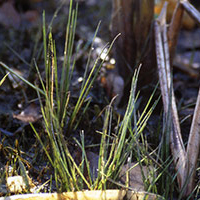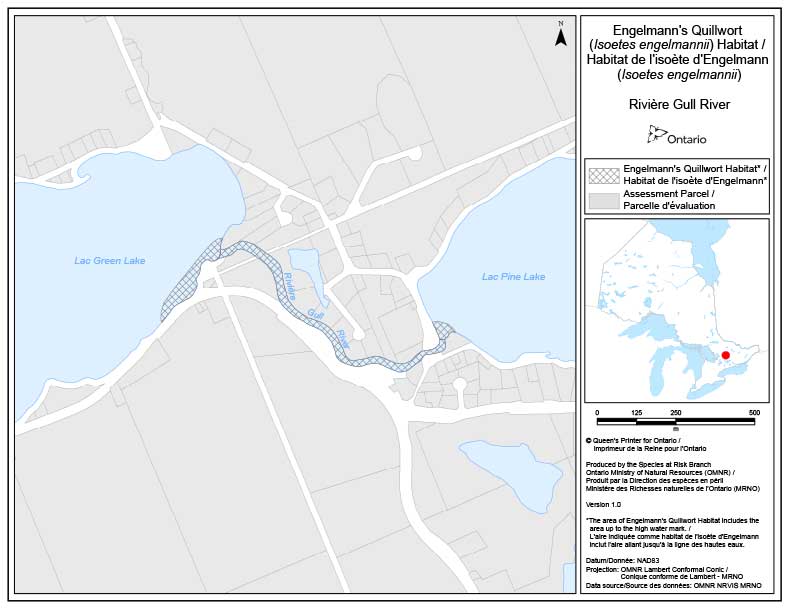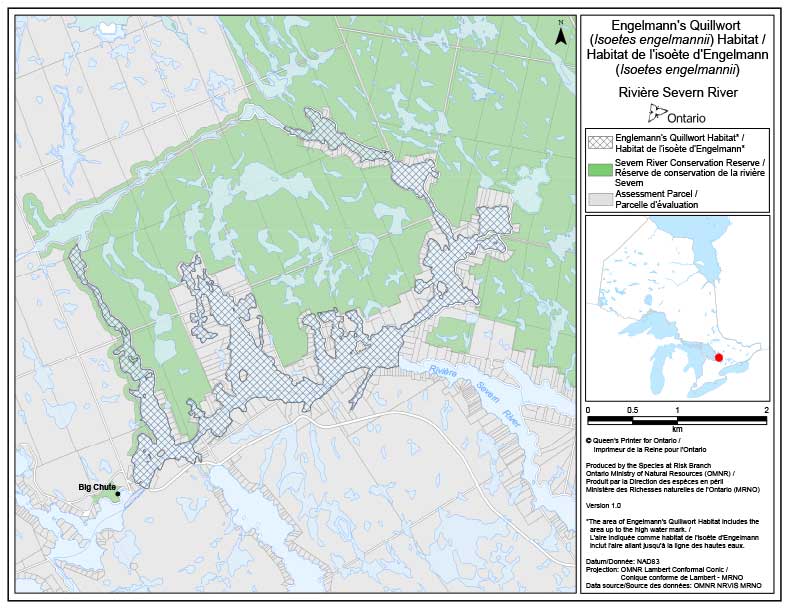Engelmann’s Quillwort
Scientific name: Isoëtes engelmannii

Cover photo credit: Daniel Brunton
Status
Endangered
“Endangered” means the species lives in the wild in Ontario but is facing imminent extinction or extirpation.
Date added to the Species at Risk in Ontario List
The Engelmann’s Quillwort was already assessed as endangered when the Endangered Species Act took effect in 2008.
What it looks like
Engelmann’s Quillwort is an aquatic plant that grows in shallow water in lakes and rivers. The long, thin, hollow leaves are green to yellow-green and can grow up to 20 cm in length.
While Engelmann’s Quillwort (like all quillwort species) is not a true fern, it is a member of a group of plants known as “fern allies.”
Where it’s been found in Ontario
In Canada, Engelmann’s Quillwort occurs at just two locations, both in Ontario. It was first found in the province in the 1970s.
It is an uncommon species throughout much of its main range in the eastern United States.
This range extends from New York State, south to northern Florida and west to Tennessee. Ontario populations are not genetically distinct from those found in the northern United States.
View a Larger version of this map (PDF)
What threatens it
Current threats to the survival of populations include water pollution and habitat degradation.
Action we are taking
Endangered species and their general habitat are automatically protected
Recovery strategy
A recovery strategy advises the ministry on ways to ensure healthy numbers of the species return to Ontario.
Read the executive summary (February 18, 2010)
Read the recovery strategy (February 18, 2010)
Government response statement
A government response statement outlines the actions the government intends to take or support to help recover the species.
Read the government response statement (November 18, 2010)
Five-Year Review of Progress
A five-year review reports on progress made toward protecting and recovering a species, within five years of publishing a species’ government response statement.
Read the report on progress towards the protection and recovery of 13 species at risk, including Engelmann’s Quillwort (2015)
Habitat protection
A habitat regulation defines a species' habitat and many describe features (e.g., a creek, cliff, or beach), geographic boundaries or other unique characteristics.
Read the regulation (February 18, 2010; amended September 14, 2016)
Habitat regulation maps
A habitat regulation map depicts the areas prescribed as the habitat of the species by Ontario Regulation 832/21 under the Endangered Species Act, 2007. The Engelmann’s Quillwort habitat regulation maps must be read in conjunction with the full text of Section 13 of Ontario Regulation 832/21.
Engelmann’s Quillwort (Isoetes engelmannii) Habitat – Gull River
View a larger version of this copy (PDF)
Engelmann’s Quillwort (<>Isoetes engelmannii) Habitat – Severn River
View a larger version of this copy (PDF)
February 2010 maps
The maps published on February 18, 2010 that depict the areas prescribed as the habitat of Engelmann’s Quillwort by Section 13 of Ontario Regulation 832/21 are filed in the office of the Surveyor General. The 2010 maps are identical to the 2016 maps with the exception of an administrative amendment. Requests for electronic copies of the 2010 maps may be sent to recovery.planning@ontario.ca.
What you can do
Report a sighting
- Report a sighting of an endangered animal or plant to the Natural Heritage Information Centre. Photographs with specific locations or mapping coordinates are always helpful.
Volunteer
- Volunteer with your local nature club or provincial park to participate in surveys or stewardship work focused on species at risk.
Be a good steward
- Private land owners have a very important role to play in species recovery. If you find Engelmann’s Quillwort on your land, you may be eligible for stewardship programs that support the protection and recovery of species at risk and their habitats.
- Invasive species seriously threaten many of Ontario’s species at risk. To learn what you can do to help reduce the threat of invasive species, visit:
- All aquatic species need good water quality and habitat. Shoreline activities such as building docks and other structures and removing vegetation can affect the Engelmann’s Quillwort and other aquatic plants and wildlife. If you are planning on working around water, please contact your local MNRF office for information and best practices.
- Nutrient runoff can negatively affect waterways that are home to Engelmann’s Quillwort and other aquatic species. There are programs to help farmers and other land owners choose best management practices. For example, Ontario’s new Species at Risk Farm Incentive Program is a pilot project to help eligible farms that are registered under the Canada-Ontario Environmental Farm Plan.
Report illegal activity
- Report any illegal activity related to plants and wildlife to
1-877-TIP-SMNR (847-7667) .
Quick facts
- There are several types of quillworts, and identification can be difficult. To properly identify these plants, researchers examine a part of the plant found at the base of its leaves called the “megaspore” under a microscope. Details on the megaspore let botanists know which type of quillwort it is.


